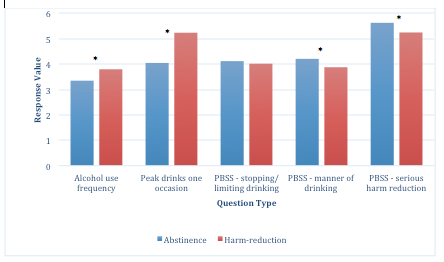The DRAM, Vol. 11(7) – Don’t preach what you practice? Abstinence vs. harm reduction parental messages and drinking among college-bound students
Editor's Note: This DRAM was written by Kelly Chen, as part of her participation in the Division on Addiction's Undergraduate Summer Research Mentorship. Kelly is a student at Williams College.
This summer, many parents will sit down and engage in conversations about drinking habits with their soon-to-be college freshmen. Although research over the past decade has established the importance of parent-teen alcohol communication in preventing alcohol-related problems, parents might still be confused about what to say during these conversations, especially when their kids have already started drinking. In this week’s DRAM, we review a recent study that compared drinking behavior among incoming freshman who primarily received abstinence or harm reduction messages from their parents (LaBrie et al., 2015).
Methods
- Researchers surveyed incoming freshman to a mid-sized University about their drinking behaviors. In total, 43% of the incoming class completed the survey.
- For the current study, the authors restricted the sample to self-identified light drinkers (n = 168; 32% of respondents).
- The questionnaires included the following questions and scales:
- Overall frequencies of parent-student alcohol communication in the past three months.
- Frequency of abstinence-related parental messages and harm reduction parental messages in the past three months, reduced to a single variable indicating whether primary parental messaging is abstinence or harm reduction.
- Abstinence-related messaging emphasizes disapproval for any type of drinking.
- Harm reduction messages instead emphasize safer-drinking practices and moderation in alcohol consumption.
- Frequency of alcohol use in the past month and maximum number of drinks on any one occasion in the past year.
- The Protective Behavioral Strategies Scale (PBSS), measuring the frequency of using 3 types of protective drinking strategies, on a scale from "never" to "always."
- Stopping/Limiting Drinking (e.g., “Determine not to drink more than a set number of drinks”).
- Manner of Drinking (e.g., “Avoid mixing different types of alcohol”)
- Serious Negative Consequences (e.g., “Know where your drink has been at all times”).
- The authors compared drinking behavior between students whose parents primarily employed abstinence messages. Each group included 84 students.
Results
- As Figure 1 shows, participants who received primarily alcohol abstinence messages from their parents (blue bars) drank less often and reported significantly fewer numbers of peak drinks than those who received primarily harm-reduction messages (red bars).
- Participants who primarily received harm reduction messages from their parents reported using fewer protective drinking strategies than those who received abstinence messages.
- These results emerged even after the researchers controlled for student gender and how often parents and students talked about alcohol.
Figure 1. Drinking Behavior of Self-Identified Light Drinkers Receiving Abstinence or Harm-Reduction Messaging (Modified from LaBrie et al., 2015). Asterisks indicate statistically significant differences.
Limitations
- This study was limited to light drinkers; relationships with parent communication might be different among heavier drinkers.
- The study did not control for additional demographic variables that might correlate with both parental messaging and drinking behaviors.
- By forcing the parental messaging variable to reflect only two options (i.e., primarily abstinence messaging or primarily harm reduction messaging), the study was not able to examine how mixed messages (i.e., receiving a combination of both abstinence and harm reduction) related to drinking behaviors.
- Because this was a cross-sectional study, we cannot conclude that parental messaging caused any of the student drinking outcomes.
Conclusions
The current study suggests that high school seniors identifying as light drinkers report drinking less and using more harm reduction strategies if their parents provide abstinence-related alcohol messages, rather than harm reduction messages. Findings from this study underscore the utility of messages related to abstinence, even when parents are aware that their children have had previous experiences with alcohol. Future research ought to examine whether this relationship carries over to the college years and whether high school parental messaging influences drinking behavior once students enter college, among both heavy and light drinkers.
– Kelly Chen
What do you think? Please use the comment link below to provide feedback on this article.
Reference
LaBrie, J., Boyle, S., & Napper, L. (2015). Alcohol abstinence or harm reduction? Parental messages for college-bound light drinkers. Addictive Behaviors, 10-13.
